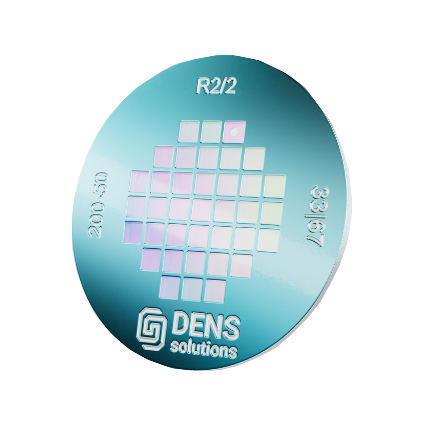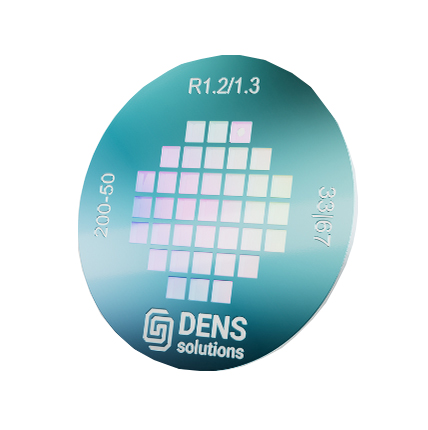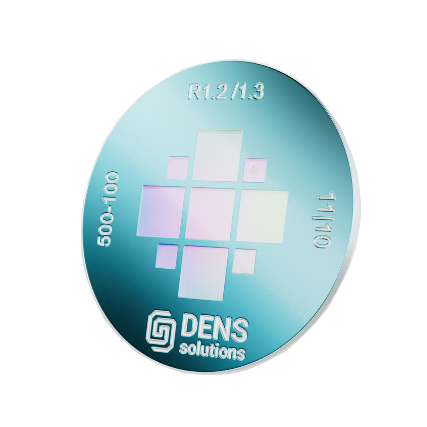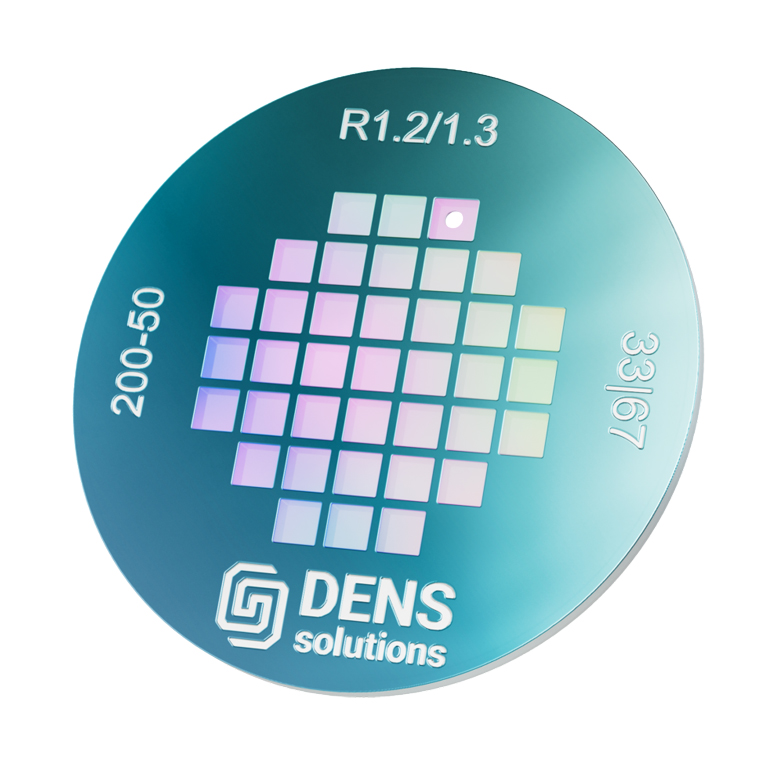Introducing CryoSilico
Get a quick glimpse of what makes this sample carrier unique.
CryoSilico Variants
Explore each CryoSilico variant and find the specs that suit your needs.
| 200 µm R2/2 | 200 µm R1.2/1.3 | 500 µm R2/2 | 500 µm R1 .2/1.3 | |
Variant |
 |
 |
 |
 |
| Specification | ||||
| Membrane size | 200 x 200 µm (mesh 70) | 200 x 200 µm (mesh 70) | 500 x 500 µm (mesh 35) | 500 x 500 µm (mesh 35) |
| Hole size | 2 µm | 1.2 µm | 2 µm | 1.2 µm |
| Hole spacing | 2 µm | 1.3 µm | 2 µm | 1.3 µm |
| Optimal for (application) | Single particle analysis | Single particle analysis | Cryo-electron tomography | Cryo-electron tomography |
| Window material | Monolayer graphene | Monolayer graphene | Monolayer graphene | Monolayer graphene |
CryoSilico Capabilities
Discover new potential for your cryo-EM experiments.
1) Unlock enhanced imaging stability
Ultra-flat graphene-coated membrane
- CryoSilico exhibits significantly less beam-induced movement compared to standard gold grids, resulting in exceptional imaging stability and quality, particularly in the first critical exposures when the protein integrity is highest.
- The ultra-flat, graphene-coated membrane is atomically smooth and topography-free, which contributes to uniform ice thickness.
- Graphene’s extreme thinness reduces energy transfer and thermal drift, ensuring consistent electron beam interaction.
1) Unlock enhanced imaging stability
Ultra-flat graphene-coated membrane
- CryoSilico exhibits significantly less beam-induced movement compared to standard gold grids, resulting in exceptional imaging stability and quality, particularly in the first critical exposures when the protein integrity is highest.
- The ultra-flat, graphene-coated membrane is atomically smooth and topography-free, which contributes to uniform ice thickness.
- Graphene’s extreme thinness reduces energy transfer and thermal drift, ensuring consistent electron beam interaction.
2) Accelerate data collection efficiency
Larger uninterrupted viewing area
- CryoSilico’s larger holes in the R2/2 variants support more exposures per hole while maintaining imaging stability.
- Its graphene support ensures consistent, high-quality imaging, even at the hole’s center—an advantage over standard grids.
- The large membranes, available in 200 µm (70 mesh) and 500 µm (35 mesh) sizes, offer up to 16x more uninterrupted viewing area. This optimized design enhances data collection speed and efficiency without compromising imaging quality.
2) Accelerate data collection efficiency
Larger uninterrupted viewing area
- CryoSilico’s larger holes in the R2/2 variants support more exposures per hole while maintaining imaging stability.
- Its graphene support ensures consistent, high-quality imaging, even at the hole’s center—an advantage over standard grids.
- The large membranes, available in 200 µm (70 mesh) and 500 µm (35 mesh) sizes, offer up to 16x more uninterrupted viewing area. This optimized design enhances data collection speed and efficiency without compromising imaging quality.
3) Maintain trusted workflows and tools
Seamless compatibility with autoloaders & vitrification tools
- Use CryoSilico with standard TFS autoloader cartridges and C-clips, keeping your workflows unchanged.
- Work effortlessly with vitrification tools like VitroBot©, Leica EM GP© and VitroJet© for maximum versatility.
- Handle samples with confidence thanks to the robust silicon frame that minimizes bending risks.
3) Maintain trusted workflows and tools
Seamless compatibility with autoloaders and vitrification tools
- Use CryoSilico with standard TFS autoloader cartridges and C-clips, keeping your workflows unchanged.
- Work effortlessly with vitrification tools like VitroBot©, Leica EM GP© and VitroJet© for maximum versatility.
- Handle samples with confidence thanks to the robust silicon frame that minimizes bending risks.
4) Achieve unparalleled reproducibility
Advanced microfabrication techniques
- Achieve consistent results with semiconductor-grade microfabrication, ensuring reproducibility in both the materials used and their precise dimensions.
- Rely on uniform quality across all carriers, thanks to wafer-level production that addresses the variability often seen in conventional grids.
- Benefit from scalable manufacturing methods that maintain quality, with potential for future customization tailored to your needs.
4) Achieve unparalleled reproducibility
Advanced microfabrication techniques
- Achieve consistent results with semiconductor-grade microfabrication, ensuring reproducibility in both the materials used and their precise dimensions.
- Rely on uniform quality across all carriers, thanks to wafer-level production that addresses the variability often seen in conventional grids.
- Benefit from scalable manufacturing methods that maintain quality, with potential for future customization tailored to your needs.
5) Streamline your experimental logistics
Unique sample carrier identifier for traceability
- Track your experiments with ease using carriers equipped with unique identifiers visible in both optical and TEM systems.
- Ensure full traceability of your samples, linking experimental results to the exact carrier used.
- Simplify data management and enhance efficiency by streamlining sample tracking throughout your workflow.
5) Streamline your experimental logistics
Unique sample carrier identifier for traceability
- Track your experiments with ease using carriers equipped with unique identifiers visible in both optical and TEM systems.
- Ensure full traceability of your samples, linking experimental results to the exact carrier used.
- Simplify logistics and enhance efficiency by streamlining sample tracking throughout your workflow.
Application results
Explore how CryoSilico outperforms standard cryo-EM grids.
Reduced beam-induced motion
CryoSilico demonstrates an impressive 50% reduction in beam-induced movement, with most exposures showing around 10Å compared to 20Å for standard gold grids with same hole size. This remarkable stability is achieved by combining our ultra-flat and strong silicon nitride membrane with the highly conductive monolayer graphene.

Source: Dr. Zhao Xiaowei from HHMI, Janelia Research Campus
Stable from the first frame
Importantly, CryoSilico minimizes beam-induced movement during the critical first exposures, preserving protein integrity when it matters most. This stability ensures higher-quality data collection from the most valuable frames.

Source: Dr. Zhao Xiaowei from HHMI, Janelia Research Campus
Enhanced particle distribution and orientation
The angular distribution of DNA-binding proteins from starved cells (Dps) from Pyrococcus furiosus was analyzed using both CryoSilico and a holey carbon grid. CryoSilico shows significantly less preferred orientation, with noticeably lower contrast compared to standard holey carbon grids. Notably, it captures a broader range of particle orientations, including intermediate ones that grids without a support layer often fail to resolve. This results in improved particle distribution and orientation, enabling more comprehensive data acquisition.

Source: Dr. Daniel Bollschweiler from MPIE
Higher data collection efficiency
CryoSilico’s large holes enable multiple exposures per hole with minimal beam-induced motion and consistent particle distribution, regardless of imaging location. Unlike standard carriers, data acquisition is possible not just near the hole’s edge but also at its center, increasing the number of shots per hole and enhancing data collection efficiency.

Source: Dr. Daniel Bollschweiler from MPIE
User Manual
Watch this detailed tutorial showcasing CryoSilico in action in the Vitrobot©.
Cryo-EM Sample Preparation
Learn more about how our solutions address common challenges in cryo-EM sample preparation.

CryoSilico: Cryo-EM
- Sample carrier challenges: CryoSilico relies on a robust silicon frame to make the handling easier, and provides an ultra-flat SiNx/graphene membrane for optimized sample support and imaging quality. Moreover, the microfabrication technology ensures faster lead-times.
- Sample deposition challenges: CryoSilico is compatible with various deposition methods, and thanks to its ultra-flat surface and the lack of grid-bars, it enables uniform sample distribution and maximizing usable viewing area.
- Vitrification challenges: CryoSilico enables reproducible and uniform ice thickness, reducing particle orientation bias. Moreover, it is fully compatible with jetting and plunging methods, ensuring reliable performance during vitrification.
Stream Infinity: In Situ Liquid-Phase TEM
- Liquid sample optimization: The Stream Infinity system enables the real-time visualization of proteins in liquid environments, allowing researchers to dynamically test and optimize experimental conditions, such as pH, salt and additives, under controlled settings. This control helps improve reproducibility and minimize air-water interface effects. Importantly, Stream Infinity helps unveil the effects of changing the biochemistry on-the-fly as a function of stimuli, such as temperature, pressure, flow rate and biasing pulses.
CryoSilico: Cryo-EM
- Sample carrier challenges: CryoSilico relies on a robust silicon frame to make the handling easier, and provides an ultra-flat SiNx/graphene membrane for optimized sample support and imaging quality. Moreover, the microfabrication technology ensures faster lead-times.
- Sample deposition challenges: CryoSilico is compatible with various deposition methods, and thanks to its ultra-flat surface and the lack of grid-bars, it enables uniform sample distribution and maximizing usable viewing area.
- Vitrification challenges: CryoSilico enables reproducible and uniform ice thickness, reducing particle orientation bias. Moreover, it is fully compatible with jetting and plunging methods, ensuring reliable performance during vitrification.
Stream Infinity: In Situ Liquid-Phase TEM
- Liquid sample optimization: The Stream Infinity system enables the real-time visualization of proteins in liquid environments, allowing researchers to dynamically test and optimize experimental conditions, such as pH, salt and additives, under controlled settings. This control helps improve reproducibility and minimize air-water interface effects. Importantly, Stream Infinity helps unveil the effects of changing the biochemistry on-the-fly as a function of stimuli, such as temperature, pressure, flow rate and biasing pulses.
Frequently Asked Questions
Uncover the answers to your most frequently asked inquiries.
General information
What applications can CryoSilico be used for?
CryoSilico (CS) is designed to be used in such CryoEM workflows as SPA, tomography, cryo-CLEM and cryo-FIB and other applications that can benefit from an ultra-flat and ultra-thin support layer.
What kind of holders can be CS used with?
CS was designed to be compatible with all TFS microscopes equipped with autoloader as it can be easily clipped in a cartridge. When clipped in TFS autogrid it can be used in other holders that are compatible with autogrid. CS also can be used when unclipped in RT and cryo side entry holders: Gatan 626, Fischione 2550.
What kind of vitrification devices is CS compatible with?
CS is compatible with all kinds of plungers. It is also compatible with the VitroJet© machine.
Is CS compatible with automated data acquisition software?
Yes, CS is designed to integrate seamlessly with popular data acquisition software systems (such as TFS EPU). Detailed alignment and calibration guides are provided to optimize imaging quality.
Does CS require changes to my standard workflow for sample preparation?
No, CS is designed to fit into standard cryoEM workflows with minimal adjustments. You can prepare samples using conventional vitrification methods without any additional equipment.
Can CS sample carriers be reused, or are they single-use?
In principle, CS sample carriers can be repurposed. Initially, they can be used for single-particle analysis (SPA), where the graphene layer plays a critical role in maintaining sample stability and integrity. After SPA, the graphene can be plasma-etched, allowing the same carriers to potentially be reused for cell culturing, in order to proceed with cryo-electron tomography (cryo-ET). This dual functionality maximizes the utility of each carrier.
Sample preparation & imaging
Does CS need to be hydrophilized before sample application?
Yes, if you need a hydrophilic surface to apply a sample, then CS should be hydrophilized before usage (refer to the CS User Manual).
When preparing a sample with blotting, do I need to use the same concentration and the same blotting parameters of a sample as with other types of grids?
The interaction with the graphene layer is sample-specific so some sample/blotting parameters optimization may be needed. One can use the parameters optimized for other types of grids as a starting point of sample optimization for CryoSilico.
How can I perform stigmation and comma-free alignment when using CS?
As graphene and SiN normally don’t produce Thon rings, beam stigmation and comma-free alignment should be performed on another grid. However, if concentration of a sample on CS is high enough, a sufficient amount of Thon rings can be produced in a hole covered with graphene and sample layer. In this case stigmation and comma-free alignment can be performed on the same CS grid.
Handling & usage
Are there any tips and tricks in CS handling and insertion into a plunger?
Yes, as CS has a thinner edge and a thicker inner part, when grabbing a carrier with tweezers one should pay attention that the tweezers’ tips grab only the thin edge of the CS while the carrier sits straight (see the Troubleshooting section in the CS Manual).
Are there any tips and tricks for clipping CS?
No, CS can be clipped exactly as other grids. You only need to make sure that the flat (graphene) side of the carrier faces the down in the cartridge when clipping (as it is also recommended for conventional grids).
Are there any tips and tricks when inserting clipped CS into a cassette?
No, clipped CS can be inserted exactly the same way as any conventional clipped grid.

Download the CryoSilico Brochure
For information on product variants, benefits and applications.

CryoSilico is part of our new cryo-EM product line and will be offered to the market through other channels than our existing products. To get a quote, please request one via the link below.
This project was made possible with financial support from the Province of South Holland, which provides funding to foster innovation and development within the region.


CryoSilico is part of our new cryo-EM product line and will be offered to the market through other channels than our existing products. To get a quote, please request one via the link below.
This project was made possible with financial support from the Province of South Holland, which provides funding to foster innovation and development within the region.

Request a quote
Request a quotation for any of our products.
Contact us
Get in touch with us for any questions you may have.

